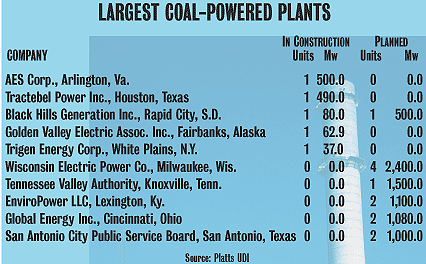A drumfire of recent project announcements has anticipated the energy-policy task forces call for more reliance on coal for powerplant fuel. Shaking off two decades of bad press, the long-time standard of U.S. power-generation fuels has cleaned up its act and is getting good reviews for being price competitive and widely available.
In 1999, even after years of environmental backlash and market-share loss to natural gas, coal-fired powerplants still generated 51% of all U.S. electricity, says the Dept. of Energys Energy Information Administration. Just five coal-fired electric generating plants totaling 1,170 Mw are now under construction in the U.S. and Canada, according to Washington, D.C.-based Platts udi, like enr, a unit of The McGraw-Hill Cos. But plans for 40 other plants, totaling 15,300 Mw, have been announced (see table).
INTEREST. Burns & McDonnell, Kansas City, used to receive perhaps one inquiry in six months about building a coal-fired plant, says Douglas Riedel, business development director. In the last nine to 12 months, that has grown to one every week or two, he says.
 |
"Most of our work on coal is the up-front work," including feasibility studies and conceptual design, says Greg Graves, Burns & McDonnell energy group general manager. He normally allows three to six months for studies, then 12 to 24 months for siting, environmental studies and permitting. "Some people are ahead of the game," he says, adding that some utilities "with exceptional vision" started studies some time ago. "Ive got studies in-house now that could break ground next summer," Graves adds.
For coal-fired plants, "the air permit and the boiler are the critical path," Graves says. He foresees a potential for boiler orders to become backlogged as gas-turbine orders now are. "I think youre going to find price escalation before the years over" up to 50%, as has happened with gas turbines, he says.
DRIVERS. Two facts are driving the return to coal, says Seth Schwartz, coal practice director at Energy Ventures Analysis Inc., Arlington, Va.: "Weve consumed our excess electric-generating capacity and we had a big increase in natural-gas prices in summer 2000." In the last six months, utilities have begun announcing construction of new coal-fired powerplants, he adds.
Coal prices reflect the increased demand. Following a 15-year slump, prices for most coals have more than doubled in the last year, says Schwartz. The industrys extended contraction has sharply reduced supply, and he expects prices to decline only slowly over the next two to three years. But given todays natural-gas prices, even high-priced coal can compete. The fuel-price difference is the key. "When the fuel-price differential for fuel delivered to the plant exceeds $2.50 per million Btu, it becomes economic" to use coal instead, he says.




Post a comment to this article
Report Abusive Comment